Saturday, October 20, 2007
Thursday, March 08, 2007
Friday, March 02, 2007
Thursday, February 15, 2007
those days when one is able to read...
''Disturbed by the reactions which play upon him from every quarter, the man of to-day is conscious, on the one hand, of a new world which is forming itself regularly, logically and clearly, which produces in a straightforward way things which are useful and usable, and on the other hand he finds himself, to his surprise, living in an old and hostile environment. This framework is his lodging; his town, his street, his house or his flat rise up against him useless, hinder him from following the same path in his leisure that he pursues in his work...
There reigns a great disagreement between the modern state of mind, which is an admonition to us, and the stifling accumulation of age-long detritus.
The problem is one of adaptation, in which the realities of our life are in question.
Society is filled with a violent desire for something which it may obtain or not. Everything lies in that: everything depends on the effort made and the attention paid to these alarming symptoms.
Architecture or Revolution.
Revolution can be avoided.''
- 'Towards a New Architecture', Le Corbusier, pp. 288-99
he wrote this indirectly refering to the social crisis that confronted france after the war... but somehow has perticular relevance in today's times... (at least in some parts of the world)
There reigns a great disagreement between the modern state of mind, which is an admonition to us, and the stifling accumulation of age-long detritus.
The problem is one of adaptation, in which the realities of our life are in question.
Society is filled with a violent desire for something which it may obtain or not. Everything lies in that: everything depends on the effort made and the attention paid to these alarming symptoms.
Architecture or Revolution.
Revolution can be avoided.''
- 'Towards a New Architecture', Le Corbusier, pp. 288-99
he wrote this indirectly refering to the social crisis that confronted france after the war... but somehow has perticular relevance in today's times... (at least in some parts of the world)
Tuesday, February 13, 2007
from a personal despair to the despair of a planet
i kept thinking about a little piece from arundhati roy's 'god of small things' till late last night...its about how personal despair has no meaning in an indian's life as it gets lost in the turmoil of the despair of the whole nation...
as my second month in the second phase of my love-hate-relationship with london starts...i inevitably found myself with an intense sense of personal despair yesterday morning, but the world that we live in doesnt allow the personal despair to last that long in a 'responsible global citizen's' life...i spent an evening with myself and half a pint of guiness in some screen/bar in borough watching 'an inconvenient truth'...i was more than skeptical about watching the documentary (despite hearing mostly positive reviews) based on a public speech by a presidential candidate from the united states and based on the 'trendiest'(?) topic in all the public debates including the ones in the fields of built environment now...it was just an idea to escape from my personal despair for me...but i did find myself in despair of 'a slowly dieing planet' instead...
its a documentary worth watching (except for slightly 'un-fitting'(?) american humour and the usual we(as US) should be 'saving the world' bits) about issues related to global warming...it is dense with information... figures... graphs... numbers ....and most importantly photographic evidence that one can not help but see with wide and sometimes watery eyes...evenif one doesnt want to seriously consider the projections made in the movie (as they are arrived at by something called 'fuzzy logic' - which is still a very gray area itself in the field of science/technology), there is enough evidence in terms of what has been happening in the last century, one cant help but be worried if his/her child would see a healthy future and snow capped mountains or not...
_ _ _ _ _
this relates me back to a few things:
. several pieces from another of roy's books - 'an ordinary person's guide to empire'
. one of my previous posts on SEZs in india, my friend R's question about whether SEZs bring problems
. several articles on politics of landgrab, loss of agriculture lands and labour reforms of indian government
. and as i see a lot of despair of the planet is the result of the corporate globalisation (even imperialism with a new label may be) i think more and more about my desire to do a phd involving the notion of power(corporations,government here) and power struggles as a main theme and a strong economic focus (corporate/global vs. agriculture,local,informal) and focus on india and the developing world...the process of germination is still going on...looks like i somehow need to find a term to replace so_much_chewd_upon 'sustainable' but try to come up with an understanding of current socio-political and economic scenario and most importantly come up with a model (may be -outline of) for 'sustainable' development for india in the global context which again has a very strong bottom-up approach instead of the top-down mad decisionmaking that is going on...
. . .
as my second month in the second phase of my love-hate-relationship with london starts...i inevitably found myself with an intense sense of personal despair yesterday morning, but the world that we live in doesnt allow the personal despair to last that long in a 'responsible global citizen's' life...i spent an evening with myself and half a pint of guiness in some screen/bar in borough watching 'an inconvenient truth'...i was more than skeptical about watching the documentary (despite hearing mostly positive reviews) based on a public speech by a presidential candidate from the united states and based on the 'trendiest'(?) topic in all the public debates including the ones in the fields of built environment now...it was just an idea to escape from my personal despair for me...but i did find myself in despair of 'a slowly dieing planet' instead...
its a documentary worth watching (except for slightly 'un-fitting'(?) american humour and the usual we(as US) should be 'saving the world' bits) about issues related to global warming...it is dense with information... figures... graphs... numbers ....and most importantly photographic evidence that one can not help but see with wide and sometimes watery eyes...evenif one doesnt want to seriously consider the projections made in the movie (as they are arrived at by something called 'fuzzy logic' - which is still a very gray area itself in the field of science/technology), there is enough evidence in terms of what has been happening in the last century, one cant help but be worried if his/her child would see a healthy future and snow capped mountains or not...
_ _ _ _ _
this relates me back to a few things:
. several pieces from another of roy's books - 'an ordinary person's guide to empire'
. one of my previous posts on SEZs in india, my friend R's question about whether SEZs bring problems
. several articles on politics of landgrab, loss of agriculture lands and labour reforms of indian government
. and as i see a lot of despair of the planet is the result of the corporate globalisation (even imperialism with a new label may be) i think more and more about my desire to do a phd involving the notion of power(corporations,government here) and power struggles as a main theme and a strong economic focus (corporate/global vs. agriculture,local,informal) and focus on india and the developing world...the process of germination is still going on...looks like i somehow need to find a term to replace so_much_chewd_upon 'sustainable' but try to come up with an understanding of current socio-political and economic scenario and most importantly come up with a model (may be -outline of) for 'sustainable' development for india in the global context which again has a very strong bottom-up approach instead of the top-down mad decisionmaking that is going on...
. . .
Sunday, November 26, 2006
permanence of temporary*
The structure of traditional medieval city of Ahmedabad- situated in western India is one, which has the ability to disappear. In its purely physical representation, the structure is very apparent or prominent. Yet in ones spatial conception, the immediate experience is of disorientation as there is no strict general reference point to experience the space in the city. This happens because the city of Ahmedabad - like a lot of other cities, especially from the developing world - works on multitude of levels, where space as represented is just one part of the whole. There are innumerable layers juxtaposed each containing different activity / acts / happenings. The complex interweaving of these layers results into the actual experience that is made up of all these temporalities in the city.
Only way to grasp the structure of the city thus is familiarizing it. Each individual here experiences the space from ones unique viewpoint. More one uses the space, the space is contextualized rich with its local references. Thus for each individual, a personalized city exists with its own references; may that be of incidents or places. It is an experience of grasping the temporalities that go undocumented in its formal representations.
Manek Chowk is a public square in the heart of old city centre of Ahmedabad. It holds layers of activities ranging from formal markets, informal economic activities, non-commercial, social and religious happenings with interdependence on one another.

The life in the big space is the ever-happening activity: constant movement of people performing in the space, passers bys, the traffic…the space gets transformed in different ways throughout the day ranging from a quiet morning to busy bustling afternoons to happening evening eateries.
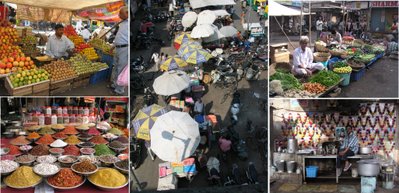

One experiences the formal (jewellers, tobacco sellers, utensils shops etc.) and the informal (bangle sellers, vegetable vendors, street side food joints etc.) simultaneously. Constant juxtaposition of activities makes it seem like a random jumble of chaotic happenings, but a more detailed observation demonstrates a perfectly organized performance with very precise interdependence of activities that are performed in these surroundings.
These temporalities have been around in Manek Chowk for the time ones memories go back. With its ever-changing forms and positions, it has now transcended the commonly accepted notion of temporality to acquire the notion of permanence. Yet, it does not become the part of the formal study on the space, functionality and its behaviours. In conventional planning norms, the informal layers (may it be economical, social, or religious activity) are either romanticised or completely ignored. Yet these are the entities that make ones experience of space actual and alive. Also, they are the ones that make the actual structure of the space and activities it supports.
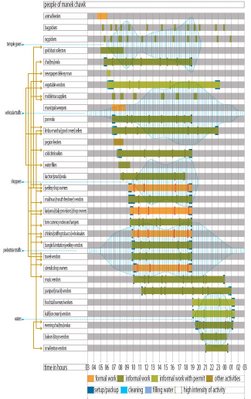
*part of the proposal submitted for an exhibition by chintan gohil and rooshank mehta
[The proposed study will try to map the area of Manek Chowk with all its events, temporalities that have become a permanent part of the big space it occupies, and break it down to a perceivable human scale.
In detail, the study will look at the space with regards to juxtapositions of various activities, coming together to make the singular experience of Manek Chowk. In different layers, It will study the range of activities happening throughout the day and night and locate the infrastructure and activities that support this complex happening. It will also plot the socio-economic relations between its players to understand the complex relationships in the space and how it moulds an individual experience.
This study in its extended form may be taken up to view / analyse the problems that lie in the seemingly informal set up of the permanence, which is ignored by the planners in the development process and provide suggestions to improve and change the urban area with better infrastructure and planning, integrating the informal as main stream.]
Only way to grasp the structure of the city thus is familiarizing it. Each individual here experiences the space from ones unique viewpoint. More one uses the space, the space is contextualized rich with its local references. Thus for each individual, a personalized city exists with its own references; may that be of incidents or places. It is an experience of grasping the temporalities that go undocumented in its formal representations.
Manek Chowk is a public square in the heart of old city centre of Ahmedabad. It holds layers of activities ranging from formal markets, informal economic activities, non-commercial, social and religious happenings with interdependence on one another.

The life in the big space is the ever-happening activity: constant movement of people performing in the space, passers bys, the traffic…the space gets transformed in different ways throughout the day ranging from a quiet morning to busy bustling afternoons to happening evening eateries.


One experiences the formal (jewellers, tobacco sellers, utensils shops etc.) and the informal (bangle sellers, vegetable vendors, street side food joints etc.) simultaneously. Constant juxtaposition of activities makes it seem like a random jumble of chaotic happenings, but a more detailed observation demonstrates a perfectly organized performance with very precise interdependence of activities that are performed in these surroundings.
These temporalities have been around in Manek Chowk for the time ones memories go back. With its ever-changing forms and positions, it has now transcended the commonly accepted notion of temporality to acquire the notion of permanence. Yet, it does not become the part of the formal study on the space, functionality and its behaviours. In conventional planning norms, the informal layers (may it be economical, social, or religious activity) are either romanticised or completely ignored. Yet these are the entities that make ones experience of space actual and alive. Also, they are the ones that make the actual structure of the space and activities it supports.

*part of the proposal submitted for an exhibition by chintan gohil and rooshank mehta
[The proposed study will try to map the area of Manek Chowk with all its events, temporalities that have become a permanent part of the big space it occupies, and break it down to a perceivable human scale.
In detail, the study will look at the space with regards to juxtapositions of various activities, coming together to make the singular experience of Manek Chowk. In different layers, It will study the range of activities happening throughout the day and night and locate the infrastructure and activities that support this complex happening. It will also plot the socio-economic relations between its players to understand the complex relationships in the space and how it moulds an individual experience.
This study in its extended form may be taken up to view / analyse the problems that lie in the seemingly informal set up of the permanence, which is ignored by the planners in the development process and provide suggestions to improve and change the urban area with better infrastructure and planning, integrating the informal as main stream.]
Wednesday, November 08, 2006
the introduction of modernism in india
. golconde, pondicherry, tamilnadu, southeast india
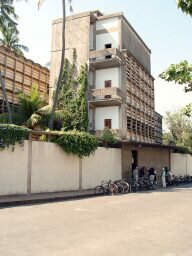
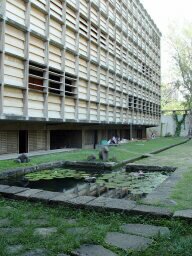
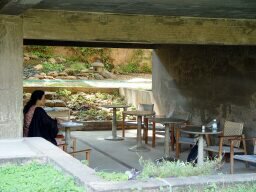
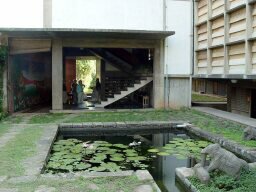

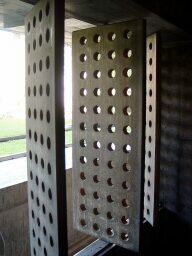


.
a dormitory for aurobindo ashram constructed in 1942 . designed by george nakashima and antonin raymond . one of the very first cast-in-place, reinforced concrete building in india . environmentally sensitive, uncompromising construction standards
.
more: www.aia.org/SiteObjects/files/Gupta_color.pdf
.








.
a dormitory for aurobindo ashram constructed in 1942 . designed by george nakashima and antonin raymond . one of the very first cast-in-place, reinforced concrete building in india . environmentally sensitive, uncompromising construction standards
.
more: www.aia.org/SiteObjects/files/Gupta_color.pdf
.




